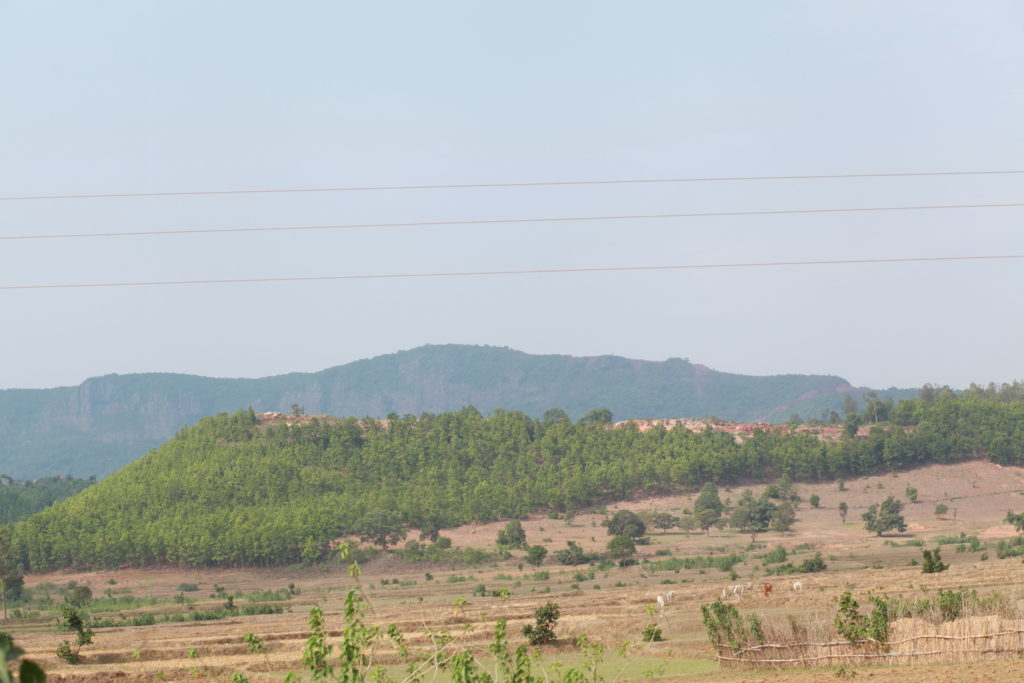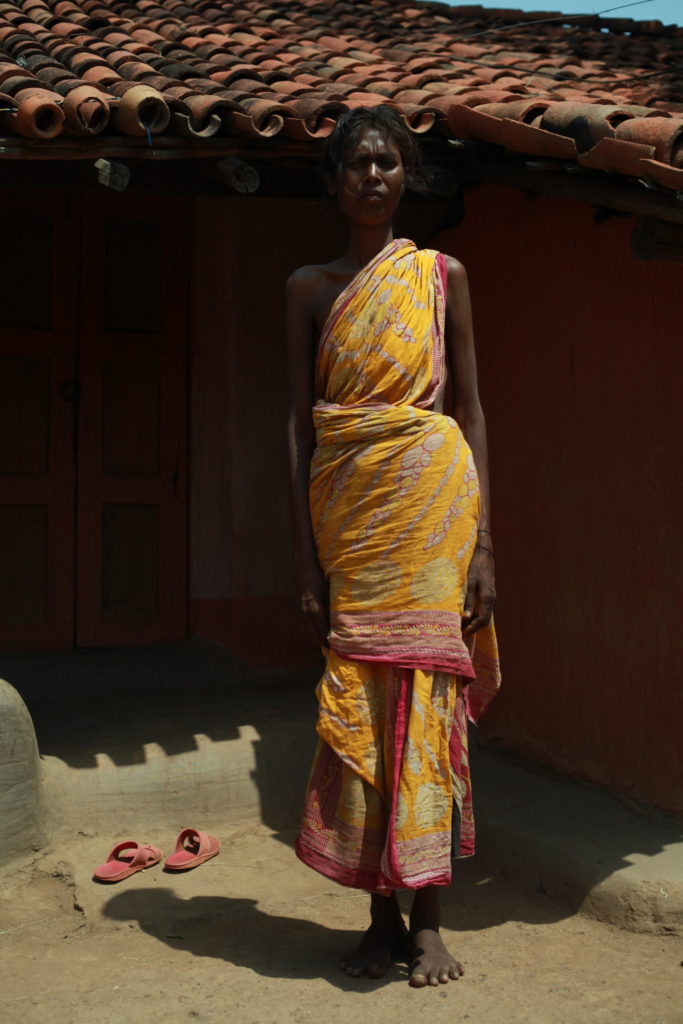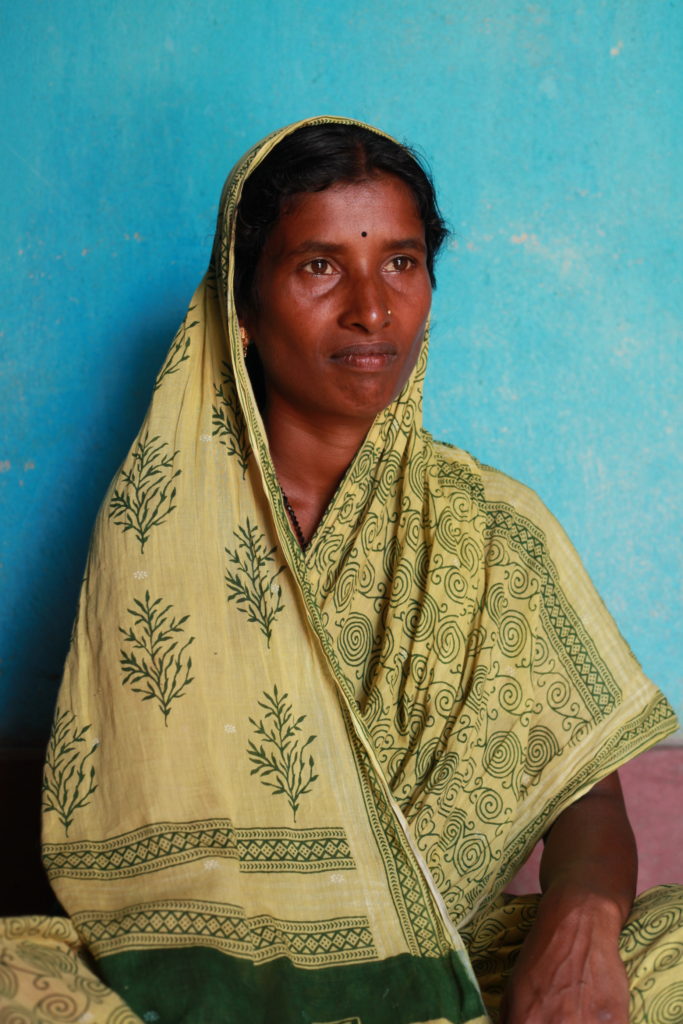
by Arpita Bisht
Madarangajodi is a quaint hamlet in the foothills lining the densely forested Indian state of Odisha with a population of about 195 people living in 54 households. Small, but neatly painted mud houses line the streets. Villagers collect mud of various colors to adorn the walls of houses, resulting in a series of dwellings with a variety of soothing, earthen colors. Each house has a courtyard and a garden, children play in common spaces, which are ample in the village, and old trees mark the beginning and end of streets. The village has a predominantly tribal population (composed of the Munda, Bhuyian, Milkawan, and Pattron tribes), who have historically been and largely still are forest dwellers.
This idyllic little hamlet, however, hides a harsh tale of exploitation, labor and human rights violations, and contamination. The village is the site of an ongoing environmental justice struggle against a private talc mining company that has operated there for over 15 years, and has resulted in the death of many miners.
Like the ghost town of Delamar, Nevada, nicknamed ‘The Widowmaker’, the deaths of the 45 miners has left 45 widows in the village over the past few years. Delamar, which witnessed a mining boom between 1893 and 1909, became the largest producer of gold within the state until 1909, and contributed significantly to employment generation and economic growth. However, large amounts of silica dust generated from gold mining resulted in the death of a large number of miners from silicosis. The exact number of people that suffered from silicosis remain unknown given the constant migration of people in and out of the mining town. The once flourishing mining colony of at least 1500 people currently lies abandoned.
Madarangajodi, unless stringent and timely action is taken, faces a similar fate. The major difference between the two is that Delamar—being a constructed mining town, enabled workers to have the option of moving back to their original home, whereas Madarangajodi is an old settlement of tribals. Indigenous inhabitants, largely income poor, often have the limited choices of either living in the environmentally polluted and socioeconomically exploitative environments, or moving to larger towns as daily wage laborers and slum dwellers.
This article presents a glimpse into the lives of the victims of environmental injustice due to mining. Although the case may appear to be an isolated event, it is only one small piece in the larger picture of the underbelly of the privatization and ecosystem exploitation-driven growth agenda that is becoming increasingly popular in India.
The mining industry in Odisha
The state of Odisha has some of the richest rainforests in India, with significant biodiversity—including endangered mega fauna such as tigers and elephants. Sacred groves of ancient trees dating back to over 500 years, found in various locations around the state, are sites of worship for local communities. Further, these regions are also home to 62 tribes, including 13 Primitive Vulnerable Tribal Groups—who have unique cultures and who are often dependent on forests and forest produce for livelihood sustenance. Incidentally, Odisha has 16.92% of total mineral reserves of the country—with chromite, nickel ore, graphite, bauxite, iron ore, manganese and coal accounting for 97.37 per cent, 95.10 per cent, 76.67 per cent, 49.74 per cent, 33.91 per cent, 28.56 per cent and 27.59 per cent respectively of the total deposits in the country. As such, the state is a prime location for the mining industry. The villages of the mining rich areas in the region have, over the past few decades, been witness to cases of police brutality, dispossessions, loss of livelihoods, spread of mining mafia, as well as Naxalism—an internal insurgency and a violent manifestation of the struggle against dispossession and often termed the greatest threat to India’s internal security.
Talc mining in Madarangajodi
Talc is a hydrous magnesium silicate and is used in various industries such as cosmetics, food, paper, pharmaceuticals, plastic, paint, coatings, rubber, electrical cable, and ceramics. Large boulders of talc are first broken into smaller pieces and then crushed using mechanical crushers—often generating large quantities of silica dust which disperses in the air during stone blasting and quarrying. This makes the talc mining industry workers extremely prone to lung disease.
Talc mining in the region has had various impacts on the local community and ecosystem. The mine has visibly consumed almost half of the hill nearby. Destruction of forest land, which is a source of livelihood given the dependence on forests of the local tribal communities, has implications on access to food and fuel. As a result of reduced access, villagers are forced to clear new spaces for agriculture and to walk farther for forest produce collection activities. Forests are also closely intertwined with tribal culture, which often means that forest clearing due to mining has impacts on traditional ecological knowledge and alters the patterns of interaction between local communities and forests. However, what forms the core of the environmental justice struggle in the region is the death of over 45 men working in the mine from silicosis.
Silicosis, also known as miners’ disease, is the most commonly occurring occupational disease for miners and stone cutters. It occurs as a result of fine particulate silica dust settling in the lungs of workers upon prolonged exposure without adequate protection for a prolonged period of time (between 5-10 years). Silicosis is an easily preventable but progressive disease that has no cure. This means that it gets progressively worse over time and the aim of treatment is limited to the reduction of symptoms and pain. Silicosis paves the way for other respiratory infections and patients often die from diseases such as tuberculosis. In mines with largely non-mechanized mining and quarrying, the chances of silicosis are extremely high.
However, prevention of the disease is not difficult. Procedures such as wet-drilling and provision of adequate safety masks which can capture the fine silica dust are some of the easy measures to be taken to prevent or at least reduce the occurrence of this lethal disease. And yet various factors such as income poverty of local residents, lack of alternative livelihood options, monetary and social power wielded by the mining companies, lack of regular checks etc., allows the companies to get away with avoiding both maintenance of safety standards and paying compensation to the affected people and families.
During our time in the village, we were taken into the house of a late-stage silicosis patient. Entering into the dark mud hut, what we saw could only be described as a barely alive, barely human figure. No muscle, no fat, only skin and bones, eyes wide and hollow due to extreme weight loss and malnourishment. The man lay on a bed, incapable of moving, of eating, drinking, or of any motion except occasional violent shivering. The torture he was going through was conveyed by the violent movements of his constantly shaking body, and a repetitive groan emanating from his throat. This man had no healthcare options, no doctors, no medicine, and no sedatives to dull his pain. He lay there in bed, awaiting an agonizing death. He received no compensation and no healthcare from the company that he dedicated over 10 years of his life to. He will leave behind a wife and three young children. He is emblematic of the face of oppression, of exploitation, of unimportant and forgotten deaths, and of the brutality of a system that favors private profit over individual human life.

The widows of Madarangajodi
The widows of Madarangajodi appear to have been the worst indirect victims of the mine. Owing to marriage at a young age, most of these women have on average two or three children whose education, nutrition, and healthcare suddenly becomes their sole responsibility. Women, especially those of the older generation, have rarely had access to work outside of the household, thus making it either difficult for them to get jobs, or forcing them to end up working in exploitative jobs. The relatively more financially stable families have the option of engaging in agriculture, but the more financially unstable and income poor are forced into daily wage labor.
These widows receive a small compensation of 1000INR (€13.7) per month by the company and 300 INR (€4.2) per month by the government. Further, the MGNREGA (Mahatma Gandhi Rural Employment Generation Act), which guarantees 100 days of paid labor per year to anyone willing to work, has allowed some of these women to get employed in small jobs such as construction of roads, government buildings, or cleaning jobs. However, often repayment of costs of medical care for their late husbands and maintenance of basic livelihood sustenance forces women to put their young children into child labor. Children as young as 8 were employed as daily wage earners in the village—often exploitative.

A mud hut in the village of Madarangajodi belonging to a relatively income poor family which has suffered the loss of the primary earner to silicosis due to talc mining. Photo: Indrajeet Rajkhowa
One woman who lost her husband to silicosis in 2006 now has the disease; their household conditions forced her to often replace her husband at work once he started falling ill on a regular basis. She has three children aged 8, 10 and 15, all of whom are currently forced to work as daily wage laborers in a nearby village since she is no longer capable of doing any laborious work, let alone grueling construction work in the heat.
Yet another woman, aged 33, whose husband happened to possess agricultural land, now farms to support her two children—a daughter aged 13 and a son aged 7. She breaks down and cries while recounting the horrors of her husbands’ disease, and her struggle to provide children with two square meals, a primary school education and to keep them from being forced into child labor. She describes the years of economic instability, the pressure of protecting her children from hunger, the struggle of protecting her land from outsiders, all the while handling the physical strain of dealing with her husband’s severe illness and soon after the emotional strain of dealing with his death. She has finally, after five years of his death, been able to afford a decent standard of living surviving off agriculture, is able to send her children to school, and has built a small two-room mud house.


Social mobilization and resistance
With the help of a local activist and some lawyers, the widows have been able to shut down the operations of the mining company by bringing the matter to the local court. As of now, about 29 court cases against the mining company have been filed by the women. However, the threat of the mining mafia looms large in the areas, often preventing them for pursuing, and sometimes forcing them to withdraw cases. For instance, on the day that we visited the village, death threats were immediately communicated to us, issued presumably in order to discourage any interventions by outsiders, and to prevent the publication of the piece in media.
The need for alternatives
Natural resources have historically formed the basis of the socioeconomic system. Whereas pre-industrial economies relied on terrestrial natural resources by using forest products, agriculture and surface water for livelihood sustenance needs, the current economic system relies on an expanded base of sub-terrestrial resources for sustenance. From groundwater to fossil fuels, metallic and non-metallic minerals—it is largely dependent on resources, often extracted in scales that have resulted in ecological degradation at the local, regional, and global level. This comes at the cost of ecosystems—either on the source-side (e.g., in the form of resource extraction) or sink-side (e.g., in the form of ‘filling’ of ecological sinks such as oceans)—evidenced by the fact that 15 out of the 24 ecosystem services quantified by the MEA are already being degraded or seeing unsustainable rates of extraction.
Since sub-terrestrial resources are not evenly distributed within the earth’s surface, specific areas with large volumes, high concentrations, and relatively pure forms of minerals tend to suffer most from exploitation. As indicated by the concept of ‘resource curse’, such regions do not often benefit directly from the appropriation of these resources. In fact, many mineral-rich regions tend to suffer the most in terms of other sectors such as education, healthcare, environmental and ecological indicators, and alternative income generation opportunities. Further, these locations are often the site of environmental injustices occurring from the imposition of negative environmental and social externalities upon local people and communities, which are increasing in frequency across the world.
Socioeconomic progress through access to electricity, sanitation, medical and healthcare facilities, and education are certainly necessary for large sections of disadvantaged populations in India, and in other parts of the world. However, looking beyond the rhetoric of pursuit of growth for the poor, there is an urgent need to examine how the real costs and benefits of economic growth are being distributed. The village of Madarangajodi, some could argue, is a small case with respect to number of victims, given the benefits of the talc mine to economic growth and industrial development in the larger context. However, the growing incidents of similar such cases of environmental injustice taking place across India highlight the urgent need to question a system which incentivizes large-scale ecosystem degradation, livelihood destruction, and associated human rights violations for the benefit of fictitious growth for the poor, and real growth for the already advantaged elite minority.
What is needed instead is a political economic system that ensures ecologically viable progress for the vast majority of the marginalized people across the country. This is not only possible, but very much practical, as has been evidenced by the hundreds of successful grassroots and community initiatives in India documented by the organization Vikalp Sangam— ‘the coming together of Alternatives’ in India. Alternatives exist and must be explored if we are to transition into a socially, economically equitable society with a sustained ecological base.
Arpita Bisht is a Doctoral Scholar studying biophysical expansion of extractivism and related socio-ecological conflicts, ecological degradation and human rights violations in India. She is interested in exploring linkages between, and implications of, social mobilization on unsustainable patterns of extractivism. Her research interests also include anthropological studies of indigenous and tribal communities with a special focus on the pluralistic conceptualization of nature as God, and on the nature of human-nature interactions in these cultures.
To receive our next article by email, click here.